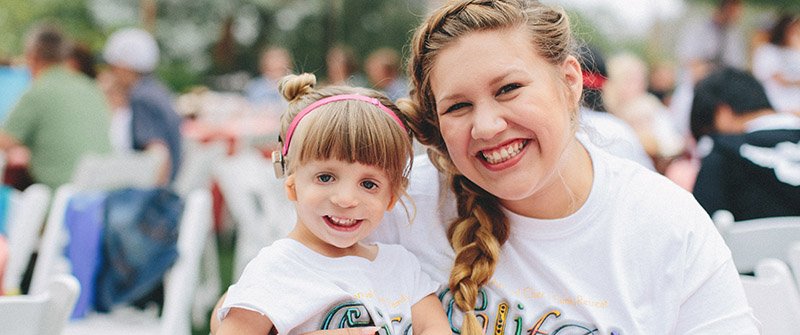Syndromes
Included in the links to the various syndromes are brief descriptions which are intended to inform and are not intended for diagnosis. A geneticist who is a member of an experienced craniofacial team should make a diagnosis.
What is a craniofacial difference (disorder)?
A craniofacial difference refers to an anomaly of the face and/or the head. Craniofacial differences can result from abnormal growth patterns of the face or skull, which involves soft tissue and bones. They can be congenital, genetic, spontaneous, and/or acquired. Medically, a craniofacial condition may be defined as including a disfigurement brought about by birth defect, disease or trauma. However, at CCA we only use the term “disfigurement” if it is preferred in a medical context. We prefer the terms difference or anomaly.
Antley-Bixler Syndrome
Antley-Bixler Syndrome is a rare genetic disorder that is primarily characterized by distinctive malformations of the head and facial (craniofacial) area and additional skeletal abnormalities. For example, the disorder is typically associated with premature closure of the fibrous joints (cranial sutures) between particular bones of the skull (craniosynostosis). Many affected infants and children also may have a prominent forehead, underdeveloped midfacial regions (midfacial hypoplasia), protruding eyes (proptosis), and other craniofacial abnormalities. Additional skeletal malformations are usually present, such as fusion of certain adjacent bones of the arms (e.g., radiohumeral or radioulnar synostosis), long, thin fingers and toes (arachnodactyly), and bowing of the thigh bones. In addition, certain joints may become permanently flexed or extended in fixed postures (joint contractures), resulting in restricted movements. Learn More
Apert Syndrome
Apert syndrome is a condition involving abnormal growth of the skull and the face due to early fusion of certain sutures of the skull. Learn More
Beare-Stevenson Syndrome
Beare-Stevenson cutis gyrata syndrome is a genetic condition characterized by skin abnormalities (cutis gyrata, which causes a furrowed and wrinkled appearance, and acanthosis nigricans) and the premature fusion of certain bones of the skull (craniosynostosis). This early fusion prevents the skull from growing normally and affects the shape of the head and face. Beare-Stevenson cutis gyrata syndrome is caused by mutations in the FGFR2 gene (like Apert Syndrome, Crouzon Syndrome, and Pfeiffer Syndrome). It is inherited in an autosomal dominant pattern, although all reported cases have resulted from new mutations in the gene and occurred in people with no history of the disorder in their family. [From NORD]
Carpenter syndrome
Carpenter Syndrome belongs to a group of rare genetic disorders known as acrocephalopolysyndactyly or ACPS disorders. All forms of ACPS are characterized by webbing or fusion (syndactyly) of certain fingers or toes (digits); and/or more than the normal number of digits (polydactyly), and by the premature closure of the fibrous joints (cranial sutures) between certain bones of the skull which is known as craniosynostosis, causing the top of the head to appear pointed, or cone shaped (acrocephaly).
Cleft Lip and/or Palate
Cleft Lip and/or Palate is a separation of the parts or segments of the lip or roof of the mouth, which are usually joined together during the early weeks in the development of a fetus. Learn More
Coffin-Lowry syndrome
Coffin-Lowry syndrome is a rare genetic disorder characterized by craniofacial (head and facial) and skeletal abnormalities, delayed intellectual development, short stature, and hypotonia. Characteristic facial features may include an underdeveloped upper jaw bone (maxillary hypoplasia), a broad nose, protruding nostrils (nares), an abnormally prominent brow, down-slanting eyelid folds (palpebral fissures), widely spaced eyes (hypertelorism), large low-set ears, and unusually thick eyebrows. Skeletal abnormalities may include abnormal front-to-back and side-to-side curvature of the spine (kyphoscoliosis), unusual prominence of the breastbone (pigeon chest, or pectus carinatum), dental abnormalities, and short, hyperextensible, tapered fingers. Other features may include feeding and respiratory problems, developmental delay, hearing impairment, awkward gait, stimulus-induced drop episodes, and heart and kidney involvement. The disorder affects males and females in equal numbers, but symptoms are usually more severe in males. The disorder is caused by a defective gene, RSK2, which is found in 1996 on the X chromosome (Xp22.2-p22.1). Thus, the syndrome is typically more severe in males because males have only one X chromosome, while females have two. It is unclear how changes (mutations) in the DNA structure of the gene lead to the clinical findings. Learn More
Craniosynostosis
Craniosynostosis means fused bones of the skull. Learn More
Crouzon syndrome
Crouzon syndrome is a condition in which sutures in the head are prematurely fused resulting in abnormal growth of the skull and face. Learn More
Facial Cleft
Facial Cleft is a rare condition in which there are areas of absent bone and sometimes overlying skin that may occur either on one or both sides of the face.
Facial Infused Lipomatosis (FIL)
FIL (also referred to as Congenital Infiltrating Lipomatosis of the Face or as Facial Infused Lipomatosis) is an ultra-rare craniofacial condition caused by a genetic mutation of the PIK3CA gene. The condition is typically visible at birth as the mutation causes an overgrowth affecting half of the face.
Facial Palsy
Facial Palsy is a congenital deformity that dates from birth, or an acquired difference, which causes complete or partial paralysis of the facial motion. Learn More
Fibrous Dysplasia
Fibrous Dysplasia is a condition of the skeleton (bones). It is a birth difference that is a non-cancerous disease. Learn More
Frontonasal Dysplasia
Frontonasal Dysplasia, also known as Median Cleft Face Syndrome, is a condition in which the nose has a flat, wide appearance, and the eyes may be wide-set. Learn More
Hallermann-Streiff syndrome
Hallermann-Streiff syndrome is a rare, congenital condition characterized mainly by abnormalities of the skull and facial bones; characteristic facial features; sparse hair; eye abnormalities; dental differences; degenerative skin changes; and proportionate short stature. Intellectual disability is present in some individuals. Almost all reported cases of the condition appear to have occurred randomly for unknown reasons (sporadically) and are thought to have resulted from a new mutation in the affected individual. Treatment is symptomatic and supportive. Learn More
Hemangioma
Hemangioma is a non-malignant tumor that is made up of rapidly growing endothel or vascular cells. CCA’s Guide to Understand Hemangiomas and Spanish Version
Goldenhar syndrome/Hemifacial Microsomia
Hemifacial Microsomia/Goldenhar syndrome is a condition in which the lower half of one side of the face does not grow normally. Learn More
Microtia/atresia
Microtia/atresia – Microtia is an incompletely formed ear. It may be just a small ear, or other variations including having only a bump of tissue at the location where the ear should normally be found. Atresia is the closing or absence of an ear canal in the middle ear. Microtia and atresia can occur alone or together. They can also be associated with hemifacial microsomia. If both ears are affected Treacher Collins syndrome may be involved.
Miller Syndrome
Miller Syndrome is very rare condition characterized by downward slanting eyelids, cleft palate, recessed lower jaw, small cup shaped ears, and a broad nasal ridge.
Moebius syndrome
Moebius syndrome is a rare congenital (present at birth) developmental disorder, characterized by absence or underdevelopment of the nerves that control facial (cranial nerve 7) and eye movements (cranial nerve 6). Learn More
Muenke syndrome
Muenke syndrome is a condition characterized by the premature closure of the coronal suture of the skull (coronal craniosynostosis) during development. This affects the shape of the head and face. Other variable features include abnormalities of the hands or feet, hearing loss, wide-set eyes, flattened cheekbones, and in about 30% of cases, some developmental delays. Muenke syndrome occurs in 1 of 30,000 newborns. Muenke syndrome is caused by mutations in the FGFR3 gene. It is inherited in an autosomal dominant pattern. Learn More
Nager syndrome
Nager Syndrome is a condition in which the facial characteristics include downward slanting eyelids, absence or underdeveloped cheekbones, a severely underdeveloped lower jaw, different outer and middle ears, clefting of the hard or soft palates, absence of lower eyelashes and scalp hair extending on the cheek. Upper limb differences include underdeveloped or missing thumbs and occasional absence of the radial limb.
Pfeiffer syndrome
Pfeiffer syndrome is a condition in which certain skull sutures are fused prematurely. Learn More
Pierre Robin Sequence
Pierre Robin Sequence is a condition in which the lower jaw is abnormally small. Learn More
Saethre-Chotzen
Saethre-Chotzen syndrome is a condition in which more than one suture is fused prematurely causing irregular head growth. Eyelids are droopy while eyes are widespread and display proptosis and may be crossed. The upper jaw may be underdeveloped. The nose may appear “beaked” and the septum may be deviated; that is, the area between the nostrils is off center. Fingers are short and certain fingers may be fused. There may be a low hairline.
Treacher Collins syndrome
Treacher Collins syndrome is a condition in which the cheek-bones and jawbones are underdeveloped. Learn More




